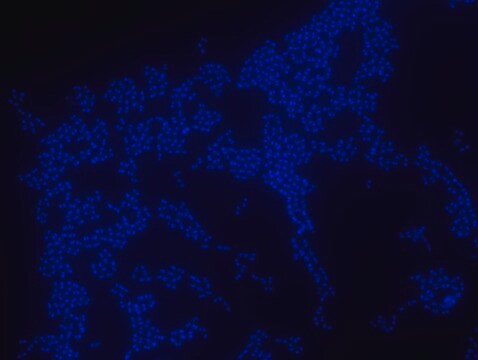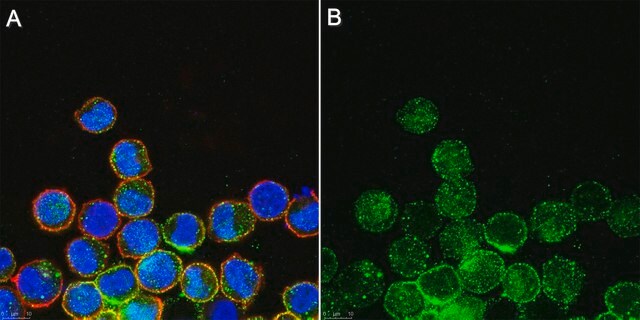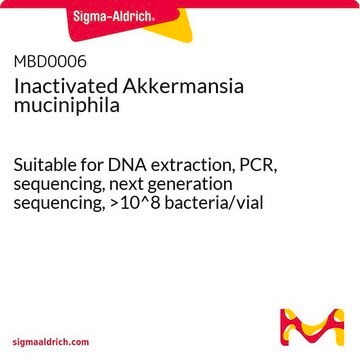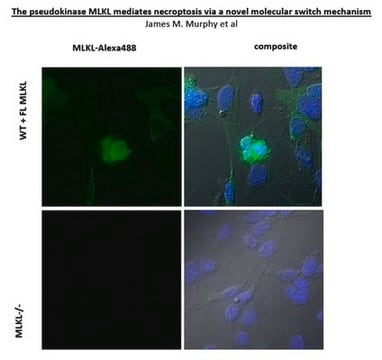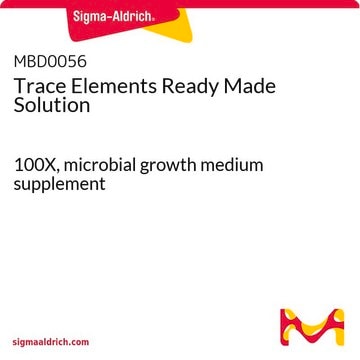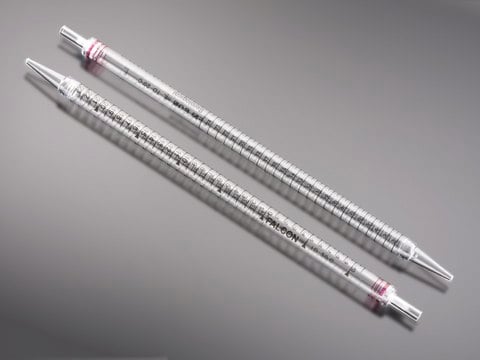MBD0050
Akkermansia muciniphila FISH probe-ATTO488
Probe for fluorescence in situ hybridization (FISH), 20µM in water
Sign Into View Organizational & Contract Pricing
All Photos(3)
About This Item
UNSPSC Code:
41105500
NACRES:
NA.54
Recommended Products
Quality Level
technique(s)
FISH: suitable
fluorescence
λex 504 nm; λem 521 nm
shipped in
dry ice
storage temp.
−20°C
General description
Fluorescent In Situ Hybridization technique (FISH) is based on the hybridization of fluorescent labeled oligonucleotide probe to a specific complementary DNA or RNA sequence in whole and intact cells.Microbial FISH allows the visualization, identification, and isolation of bacteria due to recognition of ribosomal RNA also in unculturable samples. FISH technique can serve as a powerful tool in the microbiome research field by allowing the observation of native microbial populations in diverse microbiome environments, such as samples from human origin (blood3 and tissue4), microbial ecology (solid biofilms5 and aquatic systems6) and plants7. It is strongly recommended to include positive and negative controls in FISH assays to ensure specific binding of the probe of interest and appropriate protocol conditions. We offer positive (MBD0032/33) and negative control (MBD0034/35) probes, that accompany the specific probe of interest. Akkermansia muciniphila probe specifically recognizes Akkermansia muciniphila cells. Akkermansia muciniphila is a gram negative, oval shaped, non-motile, non-spore forming strictly anaerobic bacteria.8 A. muciniphila inhabits the gastrointestinal tracts of more than 90% of adults and constitutes 1 to 4% of the fecal microbiota.9 It is one of the top 20 most abundant species detectable in the human gut.10 The mucus layer of the human intestine is a niche which is colonized by specific bacteria such as A. muciniphila. A. muciniphila can degrade mucin, a key mucus component, using the enzymes sialidase and fucosidase, and utilize it as a source of carbon and nitrogen.11 Consequently, the host produces additional mucus while the bacterium produces oligosaccharides and Short Chain Fatty Acids (SCFAs) that can be utilized by the host and trigger the immune system. An additional protective effect of the SCFA is stimulation of mucus-associated microbiota growth, that serves as a barrier against penetration of pathogens to intestinal cells.9,12 It was found that A. muciniphila abundance in the gut was correlated to a healthy intestine and inversely correlated to many disease conditions.11 In comparison to healthy controls, A. muciniphila levels were low in patients with intestinal disorders, such as inflammatory bowel disease (IBD), but also in other conditions, such as autism, atopy, and obesity.11,13-16 Therefore, the level of A. muciniphila was suggested to serve as a biomarker for healthy intestine.17 A. muciniphila is a promising potential probiotic that can be administrated for the treatment of diseases such as, colitis, metabolic syndromes, immune diseases, and cancer.10 FISH technique was successfully used to identify A. muciniphila with the probe in various samples such as pure culture (as described in the figure legends18), fecal samples19-21, gut lumen content22, appendix samples23, cecum content and tissue24,25 and colon tissue26. The probe can also be used for FISH coupled with flow cytometry (FCM-FISH)19,20,21, and FISH combined with Raman microspectroscopy
Features and Benefits
- Visualize, identify, and isolate Akkermansia muciniphila cells.
- Observe native A. muciniphila cell populations in diverse microbiome environments.
- Specific, sensitive, and robust identification of A. muciniphila in bacterial mixed population.
- Specific, sensitive, and robust identification even when A. muciniphila is in low abundance in the sample.
- FISH can complete PCR based detection methods by avoiding contaminant bacteria detection.
- Provides information on A. muciniphila morphology.
- Identify A. muciniphila in clinical samples such as, gut lumen content, appendix samples (formalin-fixed paraffin-embedded (FFPE) samples), fecal samples and colon tissue.
- The ability to detect A. muciniphila in its natural habitat is an essential tool for studying host-microbiome interaction.
Storage Class Code
12 - Non Combustible Liquids
WGK
WGK 1
Flash Point(F)
Not applicable
Flash Point(C)
Not applicable
Certificates of Analysis (COA)
Search for Certificates of Analysis (COA) by entering the products Lot/Batch Number. Lot and Batch Numbers can be found on a product’s label following the words ‘Lot’ or ‘Batch’.
Already Own This Product?
Find documentation for the products that you have recently purchased in the Document Library.
Anna Pärtty et al.
The Journal of pediatrics, 163(5), 1272-1277 (2013-08-07)
To evaluate the impact of early prebiotic and probiotic intervention on preterm infants' well-being, crying, growth, and microbiological programming. Ninety-four preterm infants (gestational age 32-36 weeks and birth weight >1500 g) randomized to receive prebiotics (mixture of galacto-oligosaccharide and polydextrose
Ting Zhang et al.
Microbial biotechnology, 12(6), 1109-1125 (2019-04-23)
Akkermansia muciniphila (A. muciniphila), an intestinal symbiont colonizing in the mucosal layer, is considered to be a promising candidate as probiotics. A. muciniphila is known to have an important value in improving the host metabolic functions and immune responses. Moreover, A. muciniphila may
Husen Zhang et al.
Proceedings of the National Academy of Sciences of the United States of America, 106(7), 2365-2370 (2009-01-24)
Recent evidence suggests that the microbial community in the human intestine may play an important role in the pathogenesis of obesity. We examined 184,094 sequences of microbial 16S rRNA genes from PCR amplicons by using the 454 pyrosequencing technology to
A Santacruz et al.
The British journal of nutrition, 104(1), 83-92 (2010-03-09)
Obesity is associated with complications during pregnancy and increased health risks in the newborn. The objective of the present study was to establish possible relationships between gut microbiota, body weight, weight gain and biochemical parameters in pregnant women. Fifty pregnant
M Carmen Collado et al.
Applied and environmental microbiology, 73(23), 7767-7770 (2007-10-16)
Fluorescence in situ hybridization and real-time PCR analysis targeting the 16S rRNA gene of Akkermansia muciniphila were performed to determine its presence in the human intestinal tract. These techniques revealed that an A. muciniphila-like bacterium is a common member of
Our team of scientists has experience in all areas of research including Life Science, Material Science, Chemical Synthesis, Chromatography, Analytical and many others.
Contact Technical Service
